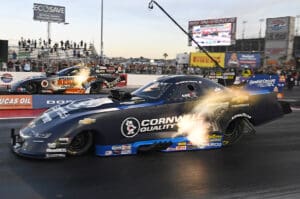

With almost 200 different classes culminating under the headings of Stock and Super Stock, those two categories harken back to the days when performance was king and “my car is faster than yours.” Today, that has somewhat changed with the basics still being run under very strict rules.
“I think it may have all started back in the days when performance cars were being built by the factories,” says long-time veteran of the sport Dave Ley.
The actual Super Stock class itself may have started as far back as the late-‘50s and early ‘60s. At the time, there were Stock classes limited to a small tire. As it turned out, cars were having a problem hooking up on the smaller tire in addition to some creative rule-bending taking place. The association’s answer was to develop two classes called S/S; one for automatic transmissions and the other stick cars. Any size tire was allowed along with any camshaft. The cars ran heads-up and the popularity grew especially in light of certain factory involvement.
Eventually, several other classes were added and along came the need to handicap the cars in some way to allow them to compete against one another in a somewhat equitable fashion. National records then became the handicap of choice with no break-out involved. It was first to the finish line. Actually, there were breakout rules in effect but were limited to a certain number under the class record. What you really had though were heads-up runs.
“It was sometime after that when the indexes were raised considerably,” says Bruce Bachelder, former NHRA official and racer himself. “It was then when everyone could run under their said index and you were allowed to ‘dial-under,’ making it essentially a bracket race under strict rules. There was a point in time, somewhere around the late ‘70s and maybe as far as 1990, where there were a lot of changes in the Stock and Super Stock classes. And I always ask, was that maybe by design?”

Still, those classes remained the place to showcase a lot of Detroit machinery, essentially “stock-appearing” cars which had an incredible talent to go fast under the rules.
A noted racer himself and one whose two sons have gone on to fame as Super Stock world champions, Tim Worner said, “A lot has changed in those classes. At a national event, you used to have to win your individual class in order to take part in the eliminator portion of the show. That’s when winning class meant something.”
When NHRA abandoned the Modified Eliminator category in the early ‘80s, some of the cars which popularized that category were moved into Super Stock Eliminator, cars which still appeared “stock” yet with hood scoops bulging on top of flat hoods. And of course around that time, NHRA introduced the GT classes in Super Stock which allowed for any production-style engine to be used in any type of car. An example would be a 1969 396/375 engine in a newer 1980s Camaro. Included in that ruling was the ability to convert a front-wheel drive vehicle to rear wheel drive using an engine listed in NHRA’s Stock Classification Guide. Today, there are so many different classes within those eliminators that it possibly makes it hard to understand. Performance may still be king, but there’s little to wonder if that is also changing.
“That however, was changing a lot back when we had the AHRA and IHRA organizations,” says Ley. “There were so many different classes under their headings that you may have had three ’69 Camaros with the same engine combination yet running in three entirely different classes.”

“It is really sad it appears no one is truly rewarding performance in Stock and Super Stock,” says Alan Roehrich. “It has driven some racers and the majority of contingency sponsors out.”
What was once a very prestigious honor to win a class title at a national event, has been changed to almost a secondary honor especially in light of the fact that class eliminations are only held at a small number of national events. The emphasis lies on the eliminator title and not so much on “my car is faster than yours.”
Take for instance, the granddaddy of them all, the U.S. Nationals. Once the event where everyone came together to see who is fastest, it wasn’t uncommon for there to be a dozen or more cars within each class battling for the class win title. A win in class also carried with it the dubious distinction of having to “tear-down,” taking apart your engine to assure its legality.
“There were years where we as NHRA Tech officials would be working day and night to maintain the integrity of the win,” says Bachelder. “Not so much today, especially in light of the fact of three-day races where there is little time to ‘tear down’ anyone.”

A class win today at the ‘Nationals involves little more than an “atta-boy” with only a small number of random category qualifiers chosen for the tear-down barn. Yet there are still those who are appreciate the “my car is faster than yours” mentality. The question may be “for how much longer?”
“I have to agree to the fact that a class win today is not what it once was,” says Jack Matyas. “It appears to still be somewhat strong with the older generation of racers, but I almost think it’s coming back especially in light of the fact of certain companies paying contingency money for a class win. The downside is there are very few races where class eliminations are held.”
“I think the biggest problem we have, and it’s a problem in everything we do today, and that’s money, the expense of it all,” says multi-time champion and engine builder Gary Stinnett. “You have a certain number of guys; and with all due respect; who are willing to spend whatever it takes to be the fastest, that it often leaves others behind. When that happens, and it has, those ‘others’ either give up or just look at the categories as a bracket race and continue on from there. I don’t know how you’d ever cure that. That’s my opinion as to why today, those categories are more looked at as a bracket race with the exception of an occasional heads-up run, but with so many different classes, it’s not as common to run across someone in your own class.”
Change is something we often dread but have to accept. Changes in drag racing may be hard to comprehend but it happens all the time, sometimes for the good and sometimes… well, we’re not sure. Stock and Super Stock are still classes that are populated with true Detroit iron, iron which not only looks good but has the performance to back up the look. Whether or not you agree with the analogy of those categories becoming a bracket race with strict performance rules, they are what they are and hopefully will continue to be for a long time.







































